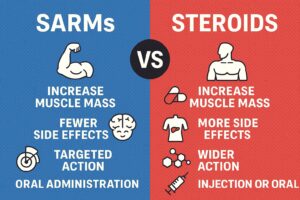In the world of performance enhancement and bodybuilding, Selective Androgen Receptor Modulators (SARMs) and anabolic steroids often come up as options for achieving muscle growth, fat loss, and improved athletic performance. Both have their proponents, but they differ significantly in their mechanisms, safety profiles, and effectiveness. This article delves into the science behind SARMs and steroids, comparing their benefits, risks, and long-term impacts to help you make an informed decision.
What Are SARMs?
SARMs are a class of compounds designed to selectively target androgen receptors in muscle and bone tissues. By mimicking the effects of testosterone, SARMs stimulate muscle growth and strength while minimizing the side effects associated with steroids. Unlike anabolic steroids, SARMs are selective in their action, meaning they aim to avoid affecting other tissues, such as the liver or prostate.
Some popular SARMs include:
- Ostarine (MK-2866): Known for muscle preservation and fat loss.
- Ligandrol (LGD-4033): Popular for bulking and strength.
- Cardarine (GW-501516): Often used for endurance and fat-burning (though technically not a SARM).
What Are Steroids?
Anabolic steroids are synthetic derivatives of testosterone, designed to increase protein synthesis and promote muscle growth. Steroids act broadly, affecting multiple tissues in the body, which often leads to significant muscle gains but also a host of unwanted side effects. Steroids are typically used in cycles and are often combined with other substances to manage side effects.
Common anabolic steroids include:
- Dianabol (Methandrostenolone): Known for rapid muscle gains.
- Testosterone Enanthate: A long-acting testosterone ester for bulking.
- Winstrol (Stanozolol): Often used for cutting and lean muscle retention.
Effectiveness: SARMs vs. Steroids
Both SARMs and steroids are effective at promoting muscle growth and fat loss, but their effectiveness varies depending on the goals and the compound used.
- Muscle Growth: Steroids generally outperform SARMs in terms of sheer muscle mass gains. Compounds like Dianabol and Trenbolone can result in significant size increases in a short time, while SARMs like Ligandrol offer moderate gains over a longer period.
- Fat Loss: SARMs are often preferred for cutting cycles due to their ability to preserve lean muscle while promoting fat burning. Cardarine, for example, enhances endurance and metabolism, aiding in fat loss.
- Strength Gains: Steroids provide dramatic strength increases, but SARMs can also improve performance, especially when used consistently.
- Speed of Results: Steroids deliver faster results, often noticeable within weeks, whereas SARMs require longer cycles for significant effects.
Safety: SARMs vs. Steroids
The biggest difference between SARMs and steroids lies in their safety profiles.
- Side Effects of Steroids
Steroids are associated with a wide range of side effects due to their broad systemic impact: - Hormonal Imbalances: Suppression of natural testosterone production, leading to testicular atrophy and infertility.
- Liver Damage: Oral steroids can be toxic to the liver.
- Cardiovascular Issues: Increased risk of high blood pressure, heart disease, and cholesterol imbalances.
- Gynecomastia: Development of breast tissue in men due to hormonal fluctuations.
- Mood Changes: Aggression, irritability, and depression (commonly referred to as “roid rage”).
- Side Effects of SARMs
While SARMs are considered safer than steroids, they are not without risks: - Hormonal Suppression: SARMs can suppress natural testosterone production, especially at high doses or extended use.
- Potential Liver Toxicity: Some SARMs, particularly oral forms, may affect liver function.
- Unknown Long-Term Effects: SARMs are relatively new, and their long-term safety remains uncertain.
Overall, SARMs have a lower risk of severe side effects compared to steroids, but they should still be used cautiously.
Legal Status: SARMs vs. Steroids
- Steroids: In most countries, anabolic steroids are classified as controlled substances. Possession or use without a prescription can lead to legal penalties.
- SARMs: SARMs occupy a legal gray area. They are often sold as “research chemicals” and are not approved for human consumption. However, they are not classified as controlled substances in many regions, making them easier to obtain than steroids.
Athletes should note that both SARMs and steroids are banned by most sports organizations and can result in disqualification if detected in doping tests.
Who Should Consider SARMs or Steroids?
The decision to use SARMs or steroids depends on individual goals, risk tolerance, and the desired speed of results.
- SARMs: Suitable for individuals looking for moderate muscle and strength gains with fewer risks. SARMs are often favored by beginners or those focused on cutting cycles.
- Steroids: Typically used by advanced athletes or bodybuilders seeking significant size and strength gains. However, the risks associated with steroids require careful management and a thorough understanding of post-cycle therapy (PCT).
The Importance of Responsible Use
Neither SARMs nor steroids should be used recklessly. Responsible use includes:
- Researching the compounds thoroughly.
- Starting with low doses to assess tolerance.
- Implementing post-cycle therapy to restore hormonal balance.
- Monitoring health through regular blood tests.
Consulting with a healthcare professional is highly recommended to mitigate potential risks.
Future Developments in Performance Enhancement
Research into SARMs continues, with newer compounds being developed for better safety and efficacy. Some SARMs are also being investigated for therapeutic use, such as treating muscle-wasting diseases and osteoporosis. Similarly, advancements in steroid formulations aim to reduce side effects while maintaining their anabolic properties.
SARMs and steroids both have their place in performance enhancement, but they cater to different needs and risk tolerances. SARMs offer a safer alternative for those seeking moderate gains with fewer side effects, while steroids provide unparalleled results for size and strength at the cost of higher risks. Ultimately, the choice between SARMs and steroids should be guided by informed decisions, realistic goals, and a commitment to health and safety.






